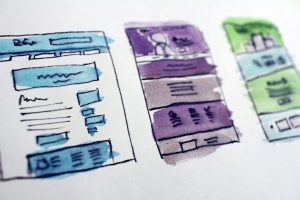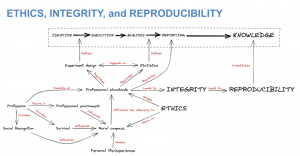Shortcuts: IxD | Éléments de Programmation | GrP
Interaction Design
 The goal of this course is to provide students basic techniques and expertise to create and evaluate the design of interactive digital products, environments, systems, and services.The course is designed for professionals who are planning to join the IT department of a large corporation or for those who might be launching a startup in the near future.
The goal of this course is to provide students basic techniques and expertise to create and evaluate the design of interactive digital products, environments, systems, and services.The course is designed for professionals who are planning to join the IT department of a large corporation or for those who might be launching a startup in the near future.
The course will combine two parallel tracks: interaction design and user experience research. Through the first track, students will learn basic theories and principles of interaction design. They will be asked to look at existing products and services through the lens of these principles to evaluate the user experience. Through the second track, students will learn research methods that will allow them to collect data that will be used to inform and guide the design of novel interactive system.
A core element of this course is the capstone project. Students will be asked to develop a novel interactive system or to evaluate an existing one and design possible improvements to it. They will work in small groups through a number of iterative steps of research and design.
Schedule: Fall Semester 2018-2019, 4.0 hours a week.
Language: English.
Videos of Final Presentations: A-Live, Moovapp.
Example of Final Presentations: Moovapp
Programming Elements
 Objectives
Objectives
The goal of this course is to provide students with knowledge and expertise on the semantics and syntax of a programming language. One specific aim of this course is to provide students basic techniques and expertise to create interactive scripts with which they will be able to analyze large amount of data, create visualization and implement algorithms to perform advanced analytical analyses.
The course will develop three separate axes: the first axis is to provide knowledge and expertise with one particular programming language, Python. The second is to bring students to develop algorithmic thinking skills, a way of getting to a solution through the clear definition of the steps needed. The third is that of providing students the ability to develop their own tool to analyze large volumes of data and provide their own creative solutions to problems they will face.
A core element of this course is the course home assignments. Through incremental home assignments, students will be guided in the development of a tool to analyze a large dataset containing a time series of stock values and make predictions for future values.
Learning outcomes
At the end of the course students should be able to:
- Understand basic Python syntax and semantics and being able to produce Python scripts to analyze datasets comprising hundreds of thousands of data points;
- Apply algorithmic thinking to problem solving: decomposing a complex problem into simpler chunks;
- Create own tool for data analysis: implement analysis technique on actual financial datasets with the aim of informing decision making.
Course structure
Time of the course will be devoted to lecture, guided examples, practice and correction of exercises (in class). Teaching will be organized in short modules followed by practical exercises and correction by the instructor.
Each week students will be assigned a practical work to do at home. The work will be returned using a learning platform provided and graded.
At the end of the course there will be a final written exam consisting of a multiple-response quiz.
Schedule: Spring Semester 2017-2018, 2.0h. course + 2.0h exercices (weekly average)
Language: Français.
Good Research Practices and Research Ethics (GRP)

The course will tackle three main areas of the contemporary debate on research excellence: research ethics, scientific integrity, and reproducibility. One of the aims of the instructors is to show how these topics are tightly interlinked. Another objective of this course is to provide students with practical tools and strategies to prevent experimental design mistakes, improve their scientific rigor, and conduct reproducible research.
The course will be taught using contrasting case studies: each core topic of the course will be presented through two case studies that reveal different facets of the same topic. Students will be asked to study the case studies, and prepare summaries highlighting the major ethical issues identified that will be presented and discussed in class.
Learning outcomes
At the end of the course students should be able to:
- Recognize design flaws of scientific studies that might lead to irreproducible research
- Refer to and integrate experimental designs that will lead to valid research results
- Provide necessary elements in their scientific reporting that will allow their research to be reproducible and replicable.
- Use commonly accepted Open Research repositories and software.
Course structure
This course is a studio/seminar. The course is organized in a reversed classroom format: each week students will have to watch a few videos detailing the theoretical content. Class time will be devoted to discussing theory, answering students’ questions, practical activities, etc. The last class of the course is a workshop: students will be invited to bring their own experimental designs and discuss how their experiments could be improved by including and considering reproducibility and ethical elements in their setups.
Students will be asked to review readings before each class and present a critique of the articles in class. The students will have to demonstrate knowledge of topics, and design and research methodologies presented during the course.
Grading of the knowledge acquisition of the course will be based on two elements:
- The project presented during the workshop;
- A final written exam consisting of open-ended questions.
COVID-19: Due to the coronavirus situation, this year the course will be taught in modality hi-flex: students will be able to choose between attending in person, attending remotely via Zoom, and following the course asynchronously. The theoretical content comes via short video recordings. Class time will be devoted to presentations, Q&A, exercises, and group activities. Classes can be attended physically or via Zoom. Because of the health evolution related to COVID-19, the study plans may be adapted during the semester.
Resources
All the content is available on the web site of the class (Moodle) and on the Ubicast channel of the course (rec.unil.ch).
The class will loosely follow the following books:
- Lazic, S. E. (2016). Experimental design for laboratory biologists: Maximising information and improving reproducibility. Cambridge University Press.
- American Psychological Association. (2020). Publication manual of the American Psychological Association (7th ed.). https://doi.org/10.1037/0000165-000
During the course, we will use different software for training and animate the classwork.
Students will need to bring their laptop to class.
Pre-requisites
- Students need to have basic knowledge of Statistics (cf. Bachelor course “Statistics”).
- We will try to adapt the technical prerequisite of the course to the audience. We will measure fluency with the following languages at signup: R, SPSS, coding/programming.
Instructor
Prof. Mauro Cherubini
mauro.cherubini@unil.ch
+41216923589
Schedule: Occurrence once a year in the fall semester.
Language: English.
